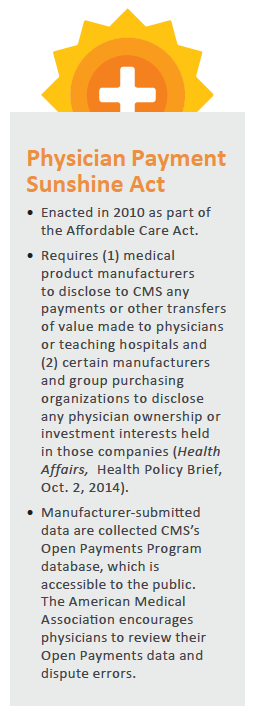Relationships Revealed: Companies Paid U.S. Cardiologists $520M in Sunshine Act’s First 3 Years
Receiving Payments Influenced Physicians’ Device Selection But Not Patient Outcomes
Industry payments to cardiologists remained largely stable in the first three years those payments were made publicly available, with biomedical manufacturers distributing about $520 million to more than 30,000 U.S. cardiologists from 2014 to 2016, according to an analysis in Circulation: Cardiovascular Quality and Outcomes (2018;11[12]:e005016).
The Physician Payments Sunshine Act was enacted in 2010 to increase the transparency of industry-physician relationships, wrote Yale School of Medicine researcher Jeptha P. Curtis, MD, and coauthors. The Open Payments Program (OPP) followed and, since August 2013, information about payments from the medical industry has been made available publicly on the OPP website.
“Among the 10 manufacturers that accounted for the majority of the total payments, only 2 manufacturers significantly decreased the value of payments to physicians over the 3 years of the study, whereas the value of payments from the remaining 8 manufacturers was largely unchanged,” Curtis and colleagues wrote. “Nevertheless, these findings only reflect 3 years of availability of the OPP data, and it may take several years for the full impact of the Sunshine Act on physician and manufacturer behavior to become apparent.”
The analysis revealed that a select minority of physicians and companies account for the majority of the payments. Only 3.5 percent of cardiologists with industry financial ties—or 1,067 people—received more than $100,000 over the three-year study period, but those doctors hauled in almost two-thirds of all payments.
Likewise, 10 manufacturers—out of 747 who made payments to physicians—dished out 60 percent of the money. Those companies provided $312 million in compensation during those three years.
For the well-compensated cardiologists, 54 percent of the payments were for speaking/promotional talks, 18 percent were for consulting fees and 12 percent were for ownership stakes. “These findings suggest that the biomedical industry maintains deeper relationships with a relatively small group of cardiologists and that these relationships are consistent from year to year,” wrote Curtis, who holds equity interest in Medtronic, and colleagues.
Manufacturers often target physicians they believe to be “thought leaders” who can influence the practice patterns of their colleagues, according to the authors. “In fact, there are firms dedicated to not only identifying key opinion leaders but also offering web services to keep track of opinion leaders and provide metrics on returns on their investment,” they wrote.
 Industry ties influence device selection
Industry ties influence device selection
Curtis and colleagues say further research is needed to better understand the impacts of financial relationships with industry on clinical decision making and whether the type or amount of payment has an effect. The preliminary findings from two studies they presented at the American Heart Association 2018 scientific sessions demonstrated that physicians with financial relationships to biomedical manufacturers were up to 12 times more likely to use an implantable cardioverter-defibrillator (ICD) or a cardiac resynchronization therapy-defibrillator (CRT-D) from that company instead of devices from others. However, patient outcomes didn’t appear to suffer based on whether the implanting physician had received payments from industry.
“I am reassured that the quality of care doesn’t differ based on whether or not you’ve received money from industry, but I am, to be honest, a little troubled by the implications of our finding that payments from industry really do influence device choice,” Curtis told Cardiovascular Business.
“I don’t think there’s anything inherently wrong about relationships between physicians and the device industry, but I do think we really need to tread carefully in that space,” he adds. “The potential for the appearance of conflicts of interest is really significant and has the potential to undermine the faith that patients put in physicians.”
Curtis’s research team used the National Cardiovascular Data Registry for ICDs to analyze device choices and intra- and postprocedural complications for operations performed by 4,096 physicians in 2014 or 2015. They found that patients of physicians who received more than $100 per year from industry experienced complications at rates similar to the patients of doctors with minimal or no financial ties to device manufacturers. The complication rates were 2.06 percent for those treated by industry-paid physicians and 2.1 percent for the other group, while in-hospital death rates were 0.32 percent and 0.24 percent, respectively.
Physicians who accepted payments from manufacturers were slightly more likely to implant a CRT-D in eligible patients (24.42 percent vs. 23.19 percent) but marginally less likely to discharge them on the “appropriate” medications of beta-blockers and angiotensin-converting enzyme inhibitors/angiotensin receptor blockers (84.17 percent vs. 85.35 percent).
The differences were substantially greater for device selection. Physicians who received the bulk of their payments from a given manufacturer were between 2.6 and 11.7 times more likely to implant a device from that company vs. another, depending on the manufacturer.
For their analysis, the authors deidentified the companies— referring to them as Manufacturers A through D—but Curtis notes a dose-dependent relationship in terms of how likely physicians were to use that device. In other words, the greater the payments from that company to a physician, the more likely the physician would select its device. Similarly, the two companies that shelled out the most money each year had the greatest likelihoods of physicians choosing their products.
Call for transparency
“This is all retrospective analysis and all we’re identifying are associations, so you have to take this with a grain of salt, but nevertheless we did see a very strong association and one that raises questions as to the appropriateness of these relationships and to what degree they are influencing physician choice,” Curtis says.
Although payments from industry to physicians and teaching hospitals are posted for public viewing on the OPP website, it isn’t exactly easy for patients to access and interpret those data, Curtis notes. He suggests hospitals could improve transparency by requiring physicians to disclose financial relationships to patients before implanting a device manufactured by a company from which they’ve received money.
“That seems practical and potentially important information for patients to know,” he says. “Similarly, I think hospital conflict of interest committees need to take their job very seriously because … the optics are not great. We want our medical decision making to be made independently of any underlying relationship with industry and to be made solely with the interest of the patient at heart.”

